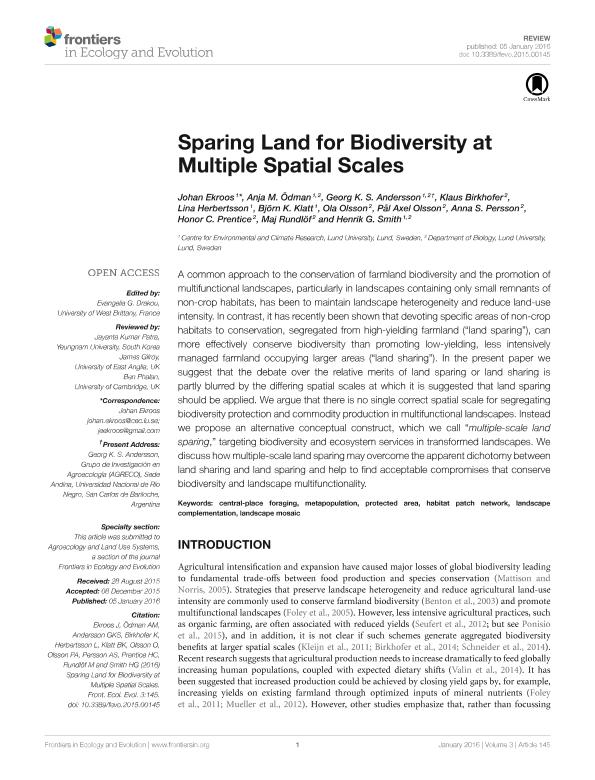Mostrar el registro sencillo del ítem
dc.contributor.author
Ekroos, Johan
dc.contributor.author
Ödman, Anja M.
dc.contributor.author
Andersson, Karl Georg Sixten

dc.contributor.author
Birkhofer, Klaus
dc.contributor.author
Herbertsson, Lina
dc.contributor.author
Klatt, Björn K.
dc.contributor.author
Olsson, Ola
dc.contributor.author
Olsson, Pål Axel
dc.contributor.author
Persson, Anna S.
dc.contributor.author
Prentice, Honor C.
dc.contributor.author
Rundlöf, Maj
dc.contributor.author
Smith, Henrik G.
dc.date.available
2018-09-18T15:11:49Z
dc.date.issued
2016-01
dc.identifier.citation
Ekroos, Johan; Ödman, Anja M.; Andersson, Karl Georg Sixten; Birkhofer, Klaus; Herbertsson, Lina; et al.; Sparing Land for Biodiversity at Multiple Spatial Scales; Frontiers Media; Frontiers in Ecology and Evolution; 3; 145; 1-2016; 1-11
dc.identifier.issn
2296-701X
dc.identifier.uri
http://hdl.handle.net/11336/60077
dc.description.abstract
A common approach to the conservation of farmland biodiversity and the promotion of multifunctional landscapes, particularly in landscapes containing only small remnants of non-crop habitats, has been to maintain landscape heterogeneity and reduce land-use intensity. In contrast, it has recently been shown that devoting specific areas of non-crop habitats to conservation, segregated from high-yielding farmland (?land sparing?), can more effectively conserve biodiversity than promoting low-yielding, less intensively managed farmland occupying larger areas (?land sharing?). In the present paper we suggest that the debate over the relative merits of land sparing or land sharing is partly blurred by the differing spatial scales at which it is suggested that land sparing should be applied. We argue that there is no single correct spatial scale for segregating biodiversity protection and commodity production in multifunctional landscA common approach to the conservation of farmland biodiversity and the promotion of multifunctional landscapes, particularly in landscapes containing only small remnants of non-crop habitats, has been to maintain landscape heterogeneity and reduce land-use intensity. In contrast, it has recently been shown that devoting specific areas of non-crop habitats to conservation, segregated from high-yielding farmland (?land sparing?), can more effectively conserve biodiversity than promoting low-yielding, less intensively managed farmland occupying larger areas (?land sharing?). In the present paper we suggest that the debate over the relative merits of land sparing or land sharing is partly blurred by the differing spatial scales at which it is suggested that land sparing should be applied. We argue that there is no single correct spatial scale for segregating biodiversity protection and commodity production in multifunctional landscapes. Instead we propose an alternative conceptual construct, which we call ?<i>multiple-scale land sparing</i>,? targeting biodiversity and ecosystem services in transformed landscapes. We discuss how multiple-scale land sparing may overcome the apparent dichotomy between land sharing and land sparing and help to find acceptable compromises that conserve biodiversity and landscape multifunctionality.apes. Instead we propose an alternative conceptual construct, which we call ?<i>multiple-scale land sparing</i>,? targeting biodiversity and ecosystem services in transformed landscapes. We discuss how multiple-scale land sparing may overcome the apparent dichotomy between land sharing and land sparing and help to find acceptable compromises that conserve biodiversity and landscape multifunctionality.
dc.format
application/pdf
dc.language.iso
eng
dc.publisher
Frontiers Media
dc.rights
info:eu-repo/semantics/openAccess
dc.rights.uri
https://creativecommons.org/licenses/by-nc-sa/2.5/ar/
dc.subject
Central Place Foraging
dc.subject
Metapopulation
dc.subject
Protected Area
dc.subject
Habitat-Patch Network
dc.subject
Landscape Complementation
dc.subject
Landscape Mosaic
dc.subject.classification
Otras Ciencias Biológicas

dc.subject.classification
Ciencias Biológicas

dc.subject.classification
CIENCIAS NATURALES Y EXACTAS

dc.title
Sparing Land for Biodiversity at Multiple Spatial Scales
dc.type
info:eu-repo/semantics/article
dc.type
info:ar-repo/semantics/artículo
dc.type
info:eu-repo/semantics/publishedVersion
dc.date.updated
2018-09-10T15:53:59Z
dc.journal.volume
3
dc.journal.number
145
dc.journal.pagination
1-11
dc.journal.pais
Suiza

dc.journal.ciudad
Lausanne
dc.description.fil
Fil: Ekroos, Johan. Lund University; Suecia
dc.description.fil
Fil: Ödman, Anja M.. Lund University; Suecia
dc.description.fil
Fil: Andersson, Karl Georg Sixten. Consejo Nacional de Investigaciones Científicas y Técnicas; Argentina. Lund University; Suecia
dc.description.fil
Fil: Birkhofer, Klaus. Lund University; Suecia
dc.description.fil
Fil: Herbertsson, Lina. Lund University; Suecia
dc.description.fil
Fil: Klatt, Björn K.. Lund University; Suecia
dc.description.fil
Fil: Olsson, Ola. Lund University; Suecia
dc.description.fil
Fil: Olsson, Pål Axel. Lund University; Suecia
dc.description.fil
Fil: Persson, Anna S.. Lund University; Suecia
dc.description.fil
Fil: Prentice, Honor C.. Lund University; Suecia
dc.description.fil
Fil: Rundlöf, Maj. Lund University; Suecia
dc.description.fil
Fil: Smith, Henrik G.. Lund University; Suecia
dc.journal.title
Frontiers in Ecology and Evolution
dc.relation.alternativeid
info:eu-repo/semantics/altIdentifier/doi/https://dx.doi.org/10.3389/fevo.2015.00145
dc.relation.alternativeid
info:eu-repo/semantics/altIdentifier/url/https://www.frontiersin.org/articles/10.3389/fevo.2015.00145/full
Archivos asociados
